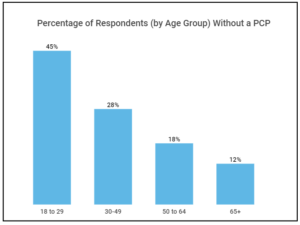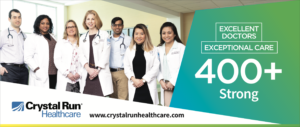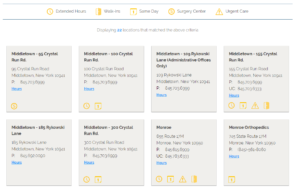Welcome to the age of on-demand medical care
These days, many Americans—particularly millennials (people born between 1981 and 1996)—don’t have a primary care physician.
Younger millennials, sometimes referred to as “digital natives,” are the first generation that grew up in the age of perpetual connectivity. They are accustomed to shopping for products and services on their own terms—and this includes healthcare.
Millennials, currently the largest demographic of people in the U.S., prefer accessing care when it’s most convenient to them (unless there’s a more complex health issue that requires regular follow up). They prize convenience over continuity, and herein lies the challenge.
A recent Kaiser Family Foundation survey of 1200 adults, commissioned by the Washington Post, revealed 26% of respondents do not have a primary care provider. Age factored largely into the responses with 45% of 18 to 29-year-olds stating they do not have a primary care provider versus just 18% for people aged 50 to 64 and 12% for those 65 and over.
So where do people, particularly younger people, go when they need a doctor? A vast majority of them are visiting urgent care, walk-in, and retail clinics (e.g., doc-in-a-box treatment centers in retail locations like Walmart, Target and CVS) to treat ailments such as urinary tract infections, cold and flu.
This behavioral shift is something healthcare providers need to be aware of, particularly when trying to differentiate themselves on issues of convenience and accessibility. According to the Washington Post piece, retail clinics offer fixed pricing and weekend and evening hours, but they can’t provide the kind of continuity of care that general practitioner provides. One-off visits to clinics and urgent care facilities can also exacerbate issues such as the over prescription of antibiotics.
The best of both worlds
People’s expectations of instant access to care, shorter wait times, and other issues can be a barrier for more traditional healthcare organizations to overcome. Patients want individualized care from compassionate providers, but they also want quick appointments and access to their provider when they need care (even if it’s on an evening or weekend).
Larger practices can deliver more services at convenient times but tend to suffer from the “assembly line” perception of care, making patients feel like they’re lost in a huge medical-industrial complex. This feeling is exacerbated when patients must wait for days, weeks or even months to be seen.
Add to this that the average time a primary care physician spends with patients is about 17 minutes (not including time spent at a computer logging electronic medical records), and it may hardly seem worth it to have a regular physician versus dropping into a clinic for a one-off issue.
The disconnect between patient wants and needs and what medical practices (and insurance companies) are willing to offer, reduces patient satisfaction, making it harder to attract new and younger patients. But it is important to recognize that the old style “family doctor’ small practice is giving way to larger groups but millennials are unfamiliar with the small practice model. Nobody has introduced them to the benefits of having continuity in their medical care, even if they only need to access it infrequently. What’s important is that the target audience begins to build a relationship with a practice that will increase over time.
The benefits of continuous care
Our client, Crystal Run Healthcare (CRHC), approached us with a dilemma—how could a practice of more than four hundred providers convey a personal, patient-centric identity to the community? They wanted to reach an increasingly elusive audience of people who have varying expectations of healthcare, not all of which are realistic.
Our solution was to develop an ad campaign that celebrates CRHC’s unique identity—including their large size—by communicating the benefits (and convenience) of having so many providers in one practice that has the scope to provide flexible, under-one-roof access to specialties.
The campaign highlights the importance of continuity of care and communicates accessibility afforded by a large network of physicians. In order to do this, their ad campaign focused not on trying to make CRHC feel like what it’s not (namely, a small local practice), but on celebrating what it is—a large practice with many specialties, providers, and a very robust support system.
The initial phase of the campaign makes the case that to have the best care, they need to have a primary care provider. The practice offers more than 28 primary care physicians with expertise in all age groups. In an area where there are a lot of young people and families with children, this means that there are providers who serve pediatric, adolescent, and adult care (including geriatrics) populations. There is a doctor for everyone.
Website content also reinforced the flexibility and accessibility of the practice by listing all office locations and clearly labeling which ones offer extended hours, walk-ins, same-day appointments and urgent care.
The Benefits of Having a Go-to Doctor
Crystal Run Healthcare is not alone in needing to draw a bright line between themselves and other practices so that the community at large can understand that these modern amenities are available close to home compared to a more traditional medical practice.
Choosing a primary care physician is a wise decision. According to Consumer Reports: “Growing research suggests that people who have a strong relationship with a physician not only report greater satisfaction with their care but also may enjoy better health. That makes sense, because having good communication and collaboration with the doctor who oversees your care can help make sure you get the tests and treatments you need, and avoid common problems, such as getting duplicative or contradictory treatments from a legion of specialists.” When marketing a group practice, no matter what their size, it’s good to know that you are helping patients access the best care available.
Conclusion
The key to any successful ad campaign is to embrace the authenticity of your organization, whatever its size. It’s also important to understand the current trends In healthcare and how patients’ needs are changing.
In order to compete with walk-in clinics and doc-in-a box types of services, traditional practices may need to address things that weren’t previously an issue for patients (like limited office hours and long wait times).
By bridging the gap between traditional healthcare paradigms such as having a family doctor with new and emerging trends such as offering extended office hours and multiple providers, practices can attract and retain new patients by giving them the healthcare they want and really need.





That’s a good point that patients want speed and efficiency, but they also want personal care from a healthcare provider. It’s probably a difficult balance for providers to find, but I imagine it’s really about listening to the patient and trying to provide them with an appealing solution. My sister-in-law has been looking for a primary care center where she can take her entire family. She’ll have to look for providers that are trying to address the new demands of patients.
I like how you pointed out that healthcare clinics need to help patients have quicker access to their providers while also giving them individualized care if they want to stay relevant. Younger generations are only going to keep changing the healthcare system as time goes on. I think the best way to handle it would be to join it and try to accommodate to their needs instead of trying to keep the traditional system alive.
Hi, David. We couldn’t agree more! Thanks for the comment.